








MIDWEEK UPDATE 30 OCTOBER 2019   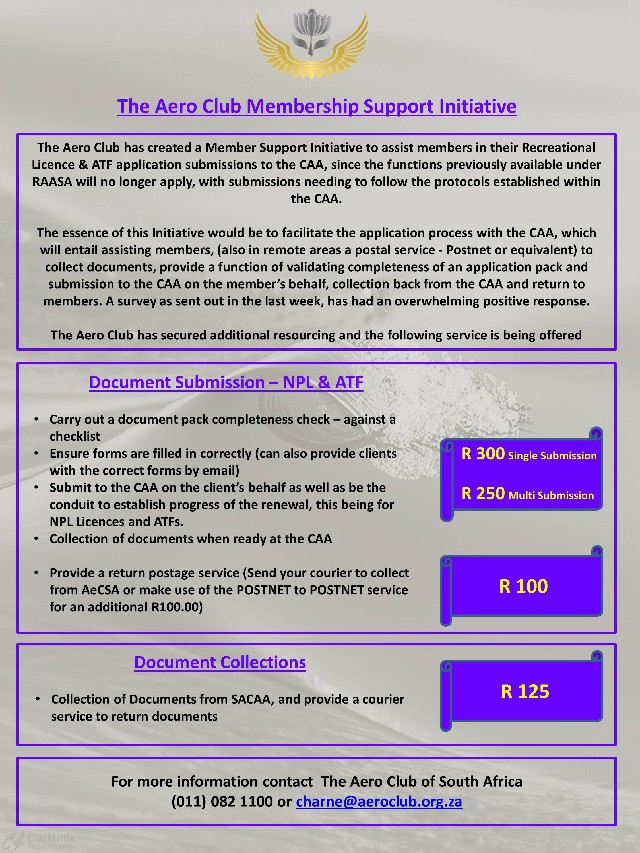      7-8: SAAMA Safari Cup. Henley Model Airfield. 8-10: EAA Sun n Fun Brits Airfield. For more information contact Marie Reddy 083 259 7691 9: EAA Sun & Fun Adventure Rally - Contact Rob Jonkers e-mail: rob@aerosud.co.za cell: 082 804 7032 15: Wings Park Fly-in. For more information contact Donald Hicks Donald@aqpm.co.za 16-17: Wavecrest Fly-in. For more information contact Donald Hicks Donald@aqpm.co.za 16: Aero Club of South Africa annual awards. Sprringbok Flying Academy Hangar, Rand Airport. For more information contact AeCSA office 011 082 1100 E-mail: office@aeroclub.org.za 22: World Canopy Piloting Championships Wonderboom South Africa. 23: SAPFA Springs Speed Rally - Springs Airfield. Contact Jonty Esser cell: 082 855 9435 e-mail: jonty@promptroofing.co.za 30: The Elders Flight, Rand Airport. SMS Felix Gosher on 066 485 0407 30: SAA Museum at Rand Airport - Airline Collectibles Fair. 30 to 1 December: SAC Ace of Base Vereeniging Airfield. Contact Annie Boon e-mail: chunge@mweb.co.za   18 - 19: SAC Gauteng Regionals Annie Boon chunge@mweb.co.za 25: Rand Airport Challenge Rally - Rand Airport Contact Frank Eckard e-mail: frank.eckard@mweb.co.za cell: 083 269 1516 25: SAPFA AGM - Time: 2 PM Rand Airport Contact Rob Jonkers e-mail: rob@aerosud.co.za cell: 082 804 7032    Absolute Aviation Group has also signed a contract for an AW119Kx and an AW109 Trekker, with a commitment to purchase further units of the various models in the next couple of years. Deliveries of the two aircraft are expected in 2020. The order marks the entrance of the AW109 Trekker, the newest light twin model in the Leonardo product range, into the South African market and builds on the significant, well established success of other AW109 variants in the country for a variety of roles. This latest AW119Kx order also grows the presence of the unique single engine helicopter in the country. A ten-day demo tour of an AW119Kx was recently completed at airports in four different regions in South Africa to showcase its extraordinary capabilities in terms of performance, advanced avionics, reliability, and versatility. The demonstrations have been deemed a significant success by those attending, accounting for nearly 50 operators who have been given the opportunity to experience its best-in-class performance and power margins, the capability to fly and carry out its mission in demanding windy conditions, in addition to its outstanding safety standards. Leonardo helicopters' success in South Africa is further strengthened by the recent contract for an AW139 helicopter in VIP configuration by a private operator. Over 60 helicopters of various models fly in the country today for both civil and government roles including VIP/corporate transport, emergency medical service, oil and gas, harbour pilot shuttle transportation, utility and naval tasks.  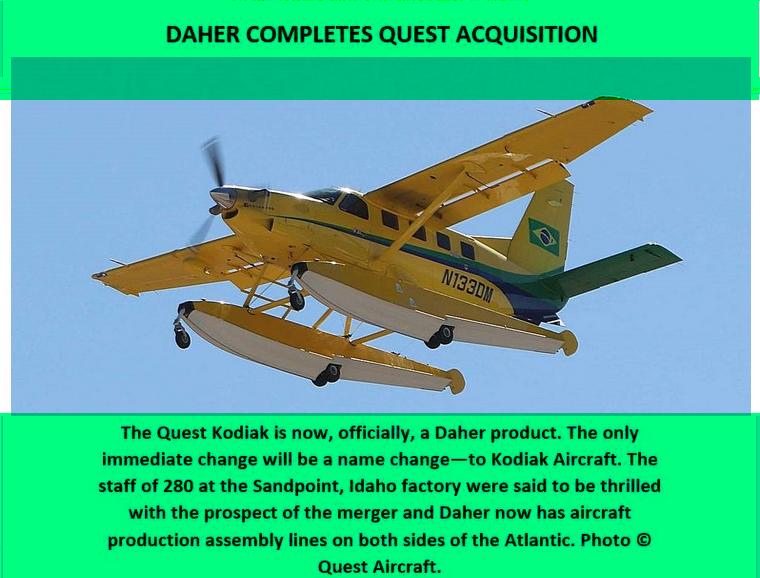 Shifting to the TBMs (the Garmin G3000 and auto throttle-equipped 940 and the G1000NXi-equipped 910), Chabbert touted the platform as a 330-knot airplane that can get to anywhere on the planet in two days "and land in less than 2,500 feet." Gaining a production toehold in North America could also have implications for Daher's ambitions to tap Silicon Valley for cooperative research projects, such as the Eco-Pulse, a joint project with Airbus and Safran.   Mark Gerritsen, Head of Training at KLM Flight Academy: "The recently delivered DA42-VI is the third airplane of this type in our fleet. Advanced avionics and very economical jet-fuel engines with a low noise level makes it an excellent training aircraft that very well prepares our students for their Type Rating training phase after completion of the DA42 lesson program." "It is great pleasure to have KLM Flight Academy on our long list of renowned international flight schools. I am sure that they will be very pleased about our 21st century trainer aircraft benefits, from a significant cut in fuel costs and reduction in noise pollution complaints to reduced transition times because of airliner like cockpits, to name only a few," said Amila Spiegel, Sales & Marketing Director at Diamond Aircraft Austria. Nearly 1,000 DA42's have been delivered since its introduction more than 14 years ago, outselling all other certified piston twins combined. The all-carbon composite DA42's are equipped with efficient, clean and reliable jet fuel Austro engines AE300, Garmin G1000 NXi with 3-axis Automatic Flight Control System and optional electrically driven air conditioning. The multi-engine trainer is in operation at many leading flight schools, such as European Flight Academy (Lufthansa Aviation Training), Embry-Riddle Aeronautical University or Lift Academy.  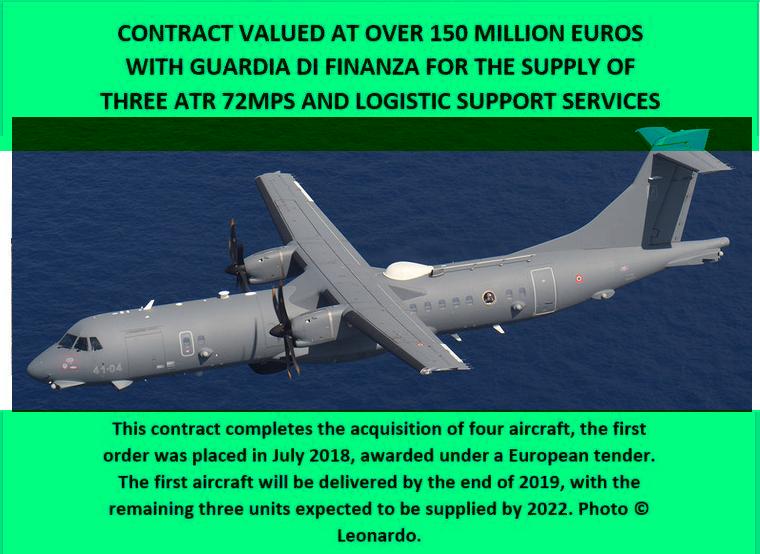 Alessandro Profumo, CEO of Leonardo, said: "We are proud that Guardia di Finanza has chosen to rely once again on our ATR 72MP, an aircraft which fully represents Leonardo's technological capabilities in terms of design and integration of platforms and systems at the highest levels." Lucio Valerio Cioffi, Aircraft Division MD at Leonardo, said: "The ATR 72MP combines reliability, low operating costs, all the advantages of the ATR 72-600 regional passenger transport aircraft together with a state-of-the-art mission system." The ATR 72MP will be integrated into the aeronautical capabilities of Guardia di Finanza, in the context of the multiple roles assigned to the Corps by the current regulatory framework. The Guardia di Finanza is the only law enforcement agency with general jurisdiction capable of exercising incisive and constant supervisory activities along the entire national coastal development and in international waters, carried out also due to the advanced technological equipment installed on its own aircraft.  Specific latest generation capabilities embedded for the first time into the ATR 72MP will be useful to support dedicated surveillance activities entrusted to the Guardia di Finanza. The ATR 72MP will operate in air-sea patrol and research missions, using on-board sensors to identify, even discreetly, sensitive objects, monitor their behaviour, acquire evidence, and lead the intervention of naval units and land patrols. The ATR 72MP - already in service with the Italian Armed Forces in a military version called P-72A - is equipped with the modular Leonardo ATOS (Airborne Tactical Observation and Surveillance) mission system. The ATOS manages the wide range of sensors of the aircraft, combining the information received in an overall tactical situation and presenting the results to the operators of the mission system in the most suitable format, providing an excellent and constantly updated scenario. Thanks to its commercial derivation, the ATR 72MP delivers its crew levels of ergonomics that increase its efficiency and effectiveness during maritime patrol, search and identification missions, SAR (search and rescue) missions, counter drug trafficking, piracy, smuggling and preventing any illegal action across the territorial waters, which can typically last more than 8 hours.  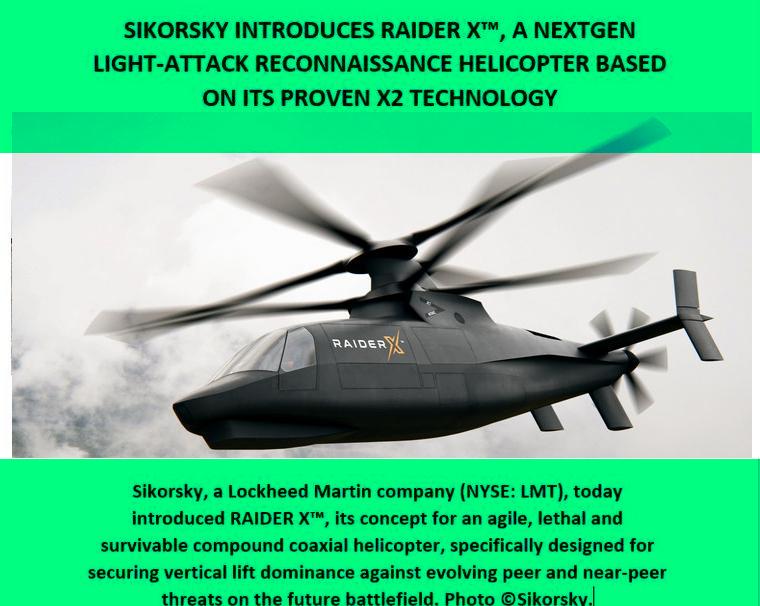 Through the U.S. Army's Future Attack Reconnaissance Aircraft (FARA) program, RAIDER X is the out-front platform in the Service's revolutionary approach for rapid development and delivery of game changing technology and war fighter capabilities, equipped for the most demanding and contested environments. RAIDER X enables the reach, protection and lethality required to remain victorious in future conflicts. RAIDER X draws on Lockheed Martin's broad expertise in developing innovative systems using the latest digital design and manufacturing techniques. Sikorsky's RAIDER X prototype offers: Exceptional Performance: The X2 rigid rotor provides increased performance including; highly responsive manoeuvrability, enhanced low-speed hover, off-axis hover, and level acceleration and braking. Agile, Digital Design: State-of-the-art digital design and manufacturing is already in use on other Lockheed Martin and Sikorsky production programs such as CH-53K, CH-148 and F-35, and will enable the Army to not only lower the acquisition cost, but enable rapid, affordable upgrades to stay ahead of the evolving threat.  Adaptability: Modern open systems architecture (MOSA)-based avionics and mission systems, offering "plug-and-play" options for computing, sensors, survivability and weapons, benefiting lethality and survivability, operational mission tailoring and competitive acquisitions. Sustainable/Maintenance: Designed to decrease aircraft operating costs by utilizing new technologies to shift from routine maintenance and inspections to self-monitoring and condition-based maintenance, which will increase aircraft availability, reduce sustainment footprint forward and enable flexible maintenance operating periods. The nationwide supply team that Sikorsky has comprised to build RAIDER X will join company leaders today to introduce RAIDER X during the annual conference of the Association of the United States Army in Washington, D.C. "RAIDER X is the culmination of decades of development, and a testament to our innovation and passion for solving our customers' needs," said Sikorsky President Dan Schultz. "By leveraging the strength of the entire Lockheed Martin Corporation, we will deliver the only solution that gives the U.S. Army the superiority needed to meet its mission requirements."  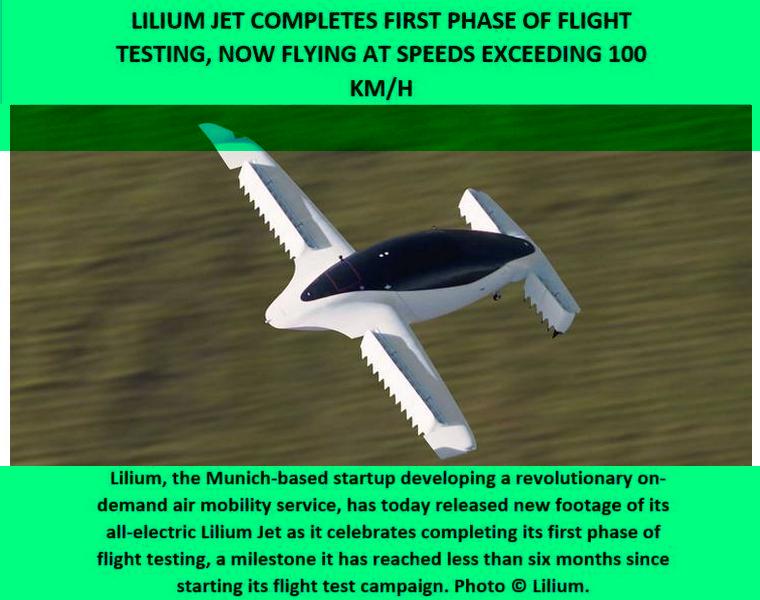 The new footage reveals, for the first time, the aircraft transitioning from vertical flight to level flight. This signature manoeuvre, first completed just weeks after the aircraft's maiden flight, is one of aerospace's greatest challenges and is what gives the Lilium Jet its significant range advantage, with its two sets of wings contributing to much higher levels of efficiency than in aircraft lifted solely by rotors. With a range of 300 km, the Lilium Jet will be capable of completing much longer journeys than the vast majority of its competitors, allowing it to connect entire regions rather than just making short trips across a single city. The release of the footage came as the company also celebrated the completion of its first dedicated manufacturing facility, an important step towards preparing the company for serial production of the Lilium Jet. The first manufacturing facility, a 3,000 square meter space located at the company's headquarters, will soon be complemented by a second, much larger, facility which is already under construction at the same site. Combined, they will support Lilium's aim of producing hundreds of aircraft a year by the time commercial services begin in 2025.  Lilium also announced an addition to its Senior Management Team, with Airbus veteran Yves Yemsi joining the team as Chief Program Officer, having worked as Head of Program Quality for the highly successful Airbus A350 aircraft. Commenting on these milestones, Daniel Wiegand, co-founder and CEO, said: "It's been thrilling to watch the Lilium Jet progress so rapidly and to see our first flying taxi manufacturing facility. We are taking tangible and concrete steps towards making our vision of regional air mobility a reality and we're doing it on time. "We believe that regional air mobility has the potential to be a remarkable force for good in society and we can't wait for what comes next."  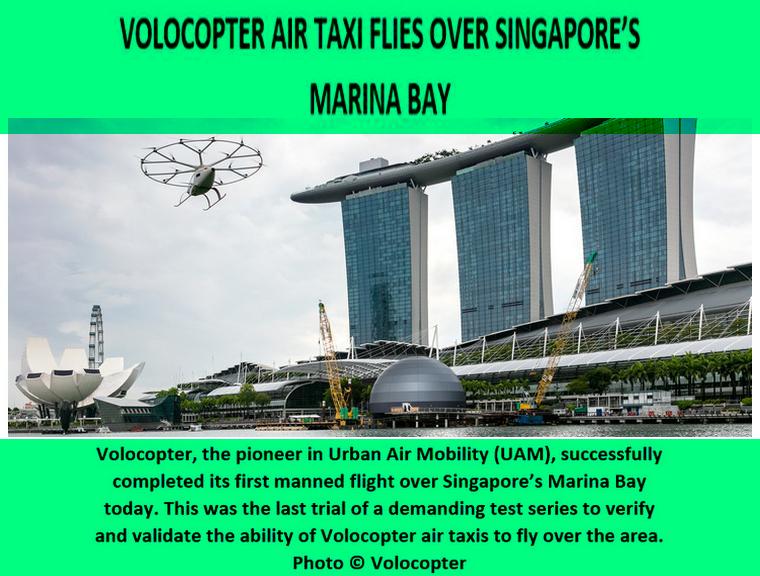 "A 2X model of the company's test series flown by a pilot onboard was used. The flight covered a distance of approximately 1.5 km and lasted for two minutes at an average cruising height of 40 m. "The flight today in Singapore was the most advanced Volocopter flight yet and the piloted flight was as stable as ever. At the same time, we are showcasing a prototype of our full-scale VoloPort Infrastructure, allowing for a realistic demonstration of air taxi boarding and maintenance services. Never before have people been this close to experiencing what Urban Air Mobility in the city of tomorrow will feel like," says Florian Reuter, CEO of Volocopter.  Leading up to the flight, the aircraft had undergone intensive testing in Germany for several months. Following which, a rigorous flight test program to verify the Volocopter 2X aircraft performance under local environment was conducted at Seletar Airport in accordance with CAAS. "Since late 2018, the Civil Aviation Authority of Singapore (CAAS) has been working with Volocopter to facilitate this flight in Singapore. The Volocopter team went through a series of stringent evaluations to ensure that all the necessary safety requirements were met before the flight was allowed to take place. By working closely with companies such as Volocopter, we hope to facilitate innovations for beneficial uses whilst ensuring aviation and public safety," said Mr. Ho Yuen Sang, Director (Aviation Industry) from CAAS. "Volocopter's decision to testbed its innovative air taxi in Singapore is testament to the opportunities and environment that Singapore provides. The Singapore Economic Development Board hopes to be an enabling partner for companies developing new mobility technologies such as autonomous vehicles and urban aerial mobility. We are happy to support Volocopter in their development plans and hope that this is a first step towards the creation of more exciting business and job opportunities in Singapore," said Mr. Tan Kong Hwee, Assistant Managing Director, EDB.  At the ITSWC, Volocopter and their partner Skyports built the first VoloPort prototype on the floating dock in Marina Bay. VoloPorts are the only physical infrastructure required for air taxis and they are one important step to commencing operations in cities. They are designed to provide passengers with a seamless air taxi experience that is safe, secure, and integrated into existing infrastructure. Volocopter opened an office in Singapore in January 2019 and has started to build up a local team to support South East Asia expansion plans. The company has recently presented their VoloCity - the next generation eVTOL air taxi which is designed to comply with EASA requirements. With their recently announced Series C funding round the company will bring the VoloCity to commercial certification.  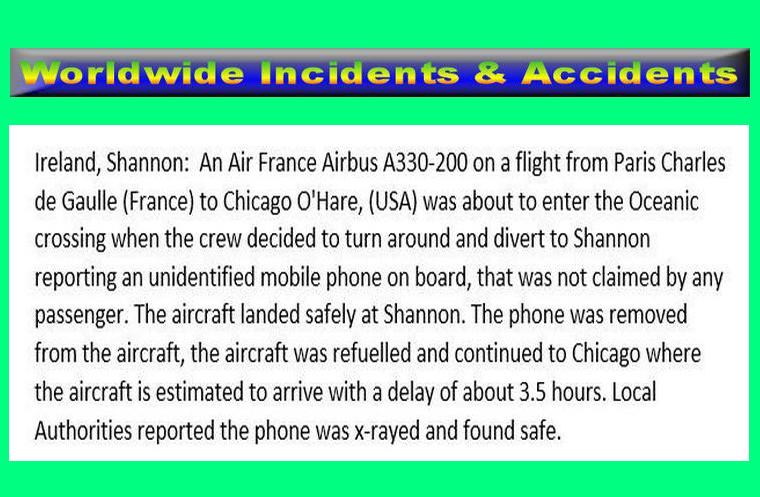 Ireland, Dublin: Two American Airlines crew members on board an Airbus A330 carrying 287 passengers and a crew of 12 on a flight from London to Philadelphia lost consciousness due to odour from cleaning fluid that spilled in the galley forcing the flight to divert to Dublin. The two crew members who became ill were treated and released. One passenger was also hospitalized. Thailand, Bangkok: A Thai Airways Boeing 777-300 with 359 on board was accelerating for take-off from Bangkok for a flight to Zurich (Switzerland) when the crew rejected take-off at low speed due to the failure of the left-hand engine (GE90). The aircraft slowed safely and returned to the apron. The left engine shows a large hole at the inboard casing.  Mexico, Madero, Coahuila: A Cessna 401A on a private flight from Durango to Acapulco-Alvarez International Airport with five on board crashed under unknown circumstances. None of the occupants survived. USA, Hebbronville, Texas: two Robinson R22 helicopters collided in midair as the pilots herded deer on a ranch in Texas. The conditions of the occupants have not been confirmed. The FAA and National Transportation Safety Board are investigating the crash. USA, Boulder City Municipal Airport: An Aero L-39 experienced a runway excursion allegedly due to the brakes overheating. The aircraft impact with a fence during the landing attempt at Boulder City Municipal Airport, Nevada. The pilot, the sole occupant, was not injured.  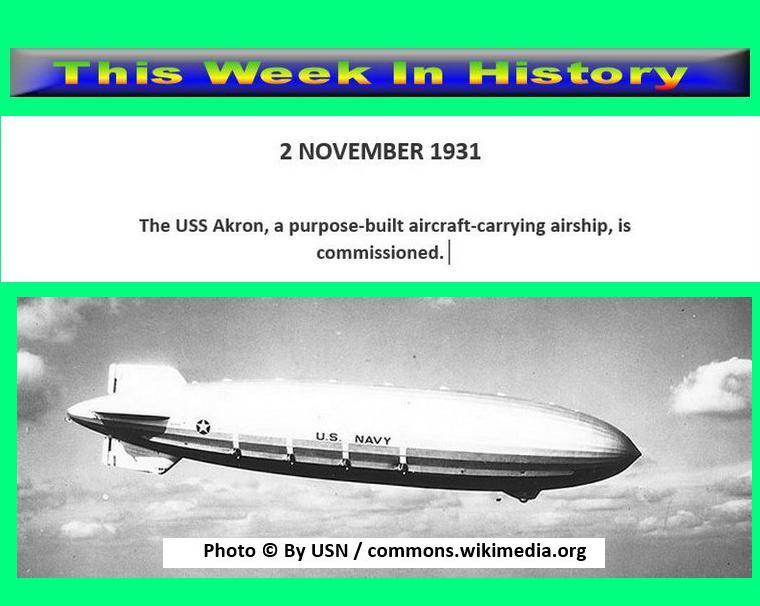 The Akron was launched on 8 August 1931. The maiden flight of the Akron took place around Cleveland on the afternoon of 23 September with Secretary of the Navy Adams and Rear Admiral Moffett on board. Akron and Macon (which was then still under construction) were regarded as potential "flying aircraft carriers", carrying parasite fighters for reconnaissance. On May 3, 1932, Akron cruised over the coast of New Jersey with Rear Admiral George C. Day-President of the Board of Inspection and Survey-on board, and for the first time tested the "trapeze" installation for in-flight handling of aircraft. The aviators who carried out those historic "landings"-first with a Consolidated N2Y trainer and then with the prototype Curtiss XF9C-1 Sparrowhawk-were Lieutenant Daniel W. Harrigan and Lieutenant Howard L. Young. The Akron was destroyed in a thunderstorm off the coast of New Jersey on the morning of 4 April 1933, killing 73 of the 76 crewmen and passengers. This accident involved the greatest loss of life in any airship crash up until that date.  |
                      |
 |
 |

Copyright © Pilot's Post PTY Ltd
The information, views and opinions by the authors contributing to Pilot's Post are not necessarily those of the editor or other writers at Pilot's Post.